Thanks to Lester Smith for the label scan and to Pat Malham and Gene Robertson for the extra information and details.
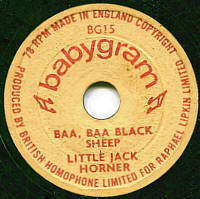
My thanks to Grahame Meachen for bringing these to my attention and for letting me have the record shown in the image.
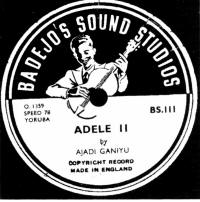
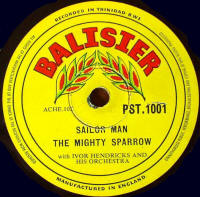
Thanks to Rainer Lotz for the label scan.
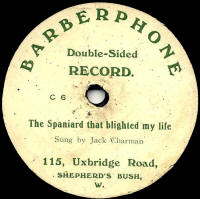
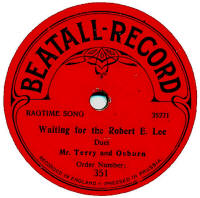
The following year, in September, Beka sent recording engineers to London to record matrices there. The exact location of the recording rooms are not known at present, but were believed to be in Islington, London. The first advertisement of Beka records for sale in Britiain was in November 1905. They would have been 8" records, and possibly both single & double sided were available.
By January 1906 they were advertistng:
8" Beka Records, single-sided (at 1/9) and double-sided (2/6)
10" Beka Grand single sided (2/6) and double sided (4/-); these had G- prefixed face numbers
11" Beka Symphonie single sided (3/-) and double sided (4/3).
None of the double-sided records had "catalogue" numbers, i.e.numbers common to both sides.
By the following year, in April 1906, they had added a 7" Beka Record at 1/- (single sided) or 1/6 (double sided).
The other styles were reduced slightly in price so that the 8" were now 1/3 and 1/10; the 10" 2/- and 3/-, the 11" 2/6 and 3/9.
In January 1907 Beka Meister records became available in Britain. These were 12" records, double-sided, selling for 6/6 each.
Up to this point, Beka were using a common series of master numbers for all sizes and recording venues, but in May 1907 they introduced different series depending on the place of recording and, in some cases, on the record size. Hence the British masters were allocated a 40000- series, which was mainly used on the 10" Beka Grand records, but also on the 12" Beka Meister records; the numbers were prefixed G for 10" and M for 12". (I don't know about the 7" & 8" records). Catalogue numbers common to both sides were still not being used.
In September 1908, the London office of the Beka agency of Otto Ruhl Ltd moved to bigger premises at 77 City Road London E.C.. This was a four-story building with the recording rooms on the top floor.
It was in October 1909 when the company started issuing records with catalogue numbers common to both sides. The first Beka Grand record so numbered was No. 216 and all the previously issued records in the catalogue were given numbers from 1 to 215.
In August 1910, the Beka business was bought out by Carl Lindström AG; the highest pre-Lindström issues being Beka-Grand 322 and Beka-Meister M25. Linsdström immediately dropped the other sizes (in fact they may already have been discontinued by this time, though it is known that some of the early 8" Beka records had already been doubled-up with catalogue numbers of X-1 to X-27).
It is likely that with the acquisition of the company by Lindström, the labels were redesigned to the more familiar styles including the logo of the stork-and-horn and the place of manufacture.
By October 1911, the British Beka-Meister masters were being numbered in a 9000 series, leaving the 40000 range for the 10" Beka-Grand only. In the Spring of 1912, the 40000 London master numbers reached 41999 and the company started a new series at 35000, which continued in use until about 1919 by which time they had reached well into the 36000s.
In late 1912, a British factory was being built for manufacturing Lindström-owned records, all of which had previously been manufactured in Germany. It was called The Mead Works, and was in Gas House Lane, Hertford and it opened in December 1912. By the time it was fully operational in March 1913, they report making 50,000 records a day (oh, yeah?). These would include not only Lindström's Beka, Coliseum & Scala records, but also Fonotipia's Jumbo and Odeon records, as Lindström had taken over the Fonitipia concern by this time. Despite the new factory in England, many Lindström-owned records were still made in Germany, where employment costs were lower.
The outbreak of World War I had little effect initially on Lindström's London business, other than they could not longer get German-recorded masters, and had to make all of the records at Hertford, but in the summer of 1916, the Board of Trade started taking action under the new "Trading with the Enemy" acts to reorganise the company and turn it iinto a wholly-owned British Company. With financial capital from the newly-created Columbia Graphophone Company, Carl Linström Ltd was "ousted" and it became The Hertford Record Company (owned by Columbia), though the personnel in the factory apparently remained the same, with Otto Ruhl on the management team. It was at this point that the Beka name on records was dropped due to its German associations, and the Jumbo records were renamed "Venus". One of the UK directors, Otto Heinemann, had left Britain in 1914 to start a new record company in America, which later issued the famous Okeh records.
A postscript to this story is that in the early 1920s a UK Beka catalogue was produced. It was undated but may have come from Otto Ruhl (1922) Ltd and could have just pre-dated the reappearance of Lindström-owned records with the new Parlophone Label in Auntumn of 1923. This Beka catalogue contained no new UK recordings, but consisted mainly of German masters dating from the outbreak of WWI up to about 1920, issued on Beka (10") and Beka Meister (12") records.
I am very grateful for the research done over the years by Frank Andrews and Bill Dean-Myatt which has enabled me to produce the above narrative.
Frank and Bill's full story of Beka/Lindstrom can be read in a booklet produced by the CLPGS (Reference Series RS11), which also includes a full listing of known issues on a data CD.
Label Designs:
The earliest Beka records all have quite a plain label and it may be that this plain design only changes following Lindstrom's takeover in 1910. This is only my opinion, and until I find out (or someone convinces me) otherwise, that is what I am assuming, even though the flamingo-and-horn trademark was used in adverts quite early on, it seems to have not appeared on the record labels until later.
I have not seen any images of a 7" Beka Record, nor of an 11" Beka Symphonie and, assuming the early (pre-Lindstrom) Beka Meisters had a different design from those shown, I've not seen any of those either.
Any scans of designs not shown here will be gratefull received!
_small.jpg)
Beka 8" c.1905
(courtesy of Norman Field)
_small.jpg)
Beka 7"
(courtesy of Richard Gregory)
Beka Grand (early)
_small.jpg)
Beka Grand with Cat No. (courtesy of Norman Field).
-------------------------------
Lindstrom Labels:
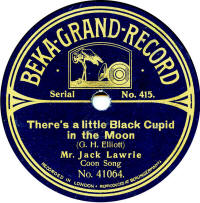
Beka Grand made in Berlin
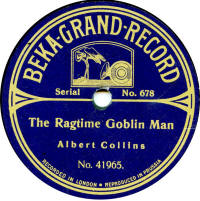
Beka Grand made in Prussia
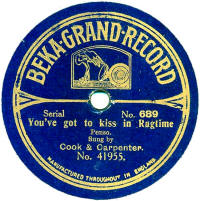
Beka Grand made in England

Beka Meister made in Germany
_small.jpg)
Beka Meister made in England (courtesy of Norman Field)
---------------------------
The following is likely to be one of those advertised in the early 1920s (courtesy of Bill Dean-Myatt)
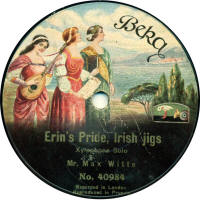
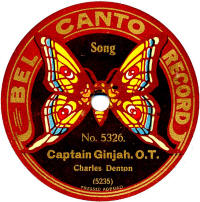
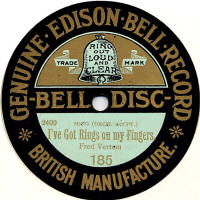
In the 1920s, Edison
Bell revived the Bell name for their 5½" (later 6") children's
label. Catalogue numbers started at 250 in 1921 and the label survived
until 1926 by which time the numbers had reached into the 400s. An
Export series using catalogue numbers starting at 700 was also produced,
with many sides specially recorded for France or Belgium. Dance
band items specially recorded for the format may be found.
All issues are British recordings. 6" recordings continued to be issued
after this time by Edison Bell, but were issued on the Crown label.

Thanks to Bill Dean-Myatt for the images.
Please e-mail me with details of ANY of these records. Also a label scan.
Please e-mail me with details of ANY of these records. Also a label scan.
Beltona records were produced for the Murdoch Trading company of 59-61 Clerkenwell Road, London, EC1.
The first Beltona records appeared just after the first world war and were made by Crystalate. This style was short-lived (probably only a few months) and copies are rare. The catalogue numbers were in a 100 series and current thinking is that they were made for export to Australia, but only 3 examples are known of at the moment. See first label scan - if you have any examples, please e-mail me)
It was 1922 before the label was revived and the pressings were taken on by Vocalion and they used their usual masters from their own recordings and from American Gennett and Vocalion. The familiar design (see third picture) was used, though initially the colours were red and buff (see second picture) rather than turquoise and light turquoise. There was also a 6" disc called Beltona Bairns produced by Vocalion at this time; the photo reproduced here shows one in its original packet.
In 1927, the label design changed to the black and white design shown here and soon after this, Edison Bell started providing the masters as Vocalion ceased any 10" recordings. By the following year, Beltona seemed to stop issuing dance music, though in the early 1930s, a few sessions of local dance bands were recorded (see scan). The label concentrated on Scottish and Irish music for the rest of its life and carried on into the 1970s, though obviously was by then in the 45rpm format.
The catalogue numbers started at 101 (for popular records) and reached about 1250 before the design change and Edison took over from about 1300. The label generally shows the correct matrix number, even though the original matrix has been expunged from the disc on many of the American matrices. The Bairns records used a 3-digit series of numbering.
NOTE: There were many other issues and series and a full listing of all Beltona issues was produced in 2007 by Bill Dean Myatt. A new edition of Bill's Beltona listing, with many amendments and including recording dates is now available in the Reference series. The booklet, at a very reasonable price has the full history and a CD with the catalogue listing which is fully searchable. This is available from the CLPGS.
The Beltona De Luxe label image is courtesy of Bill Dean-Myatt
Below the Belton Bairns record are some of the later label designs, courtesy of Ivan Ruddock.
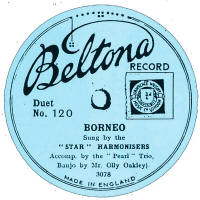
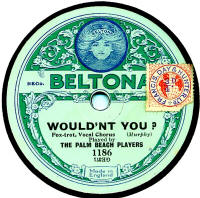
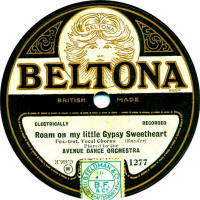
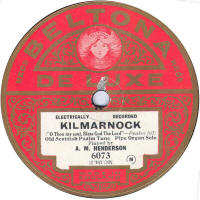

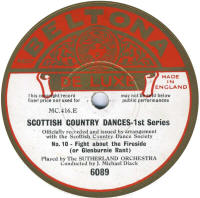
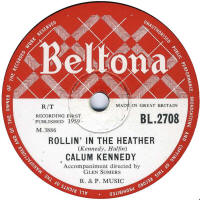
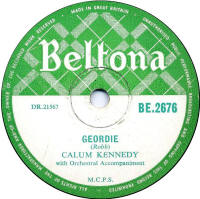
Unlike Little Marvel, however, all Beltona Bairns records were aimed at young chgildren, all having a nursery rhyme on one side, coupled with a light instrumental recording. The words to the nursery rhymes were printed on each pocket in the album.
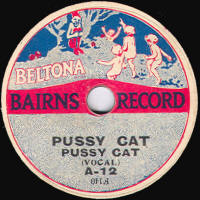
Berliner's earliest records are now generally referred to as "Berliners", as they had no "label name" and are inscribed, rather than labelled, with Berliner's name and the details of the recording, often with the recording date. (A shame this feature was dropped!)
The first disc records were 5" in diameter, quickly increasing to the more familiar 7".
In 1901, the company introduced 10" records which were briefly still called "Berliner Gramophone" but with the titling embossed in a typeface (see second image - thanks to Bob Lilley for this photo), but then printed labels were introduced and soon after, Berliner's name was dropped in favour of The Gramophone Company's name, and the records were then labelled as "Gramophone Record" (see under "Gramophone" on this site).
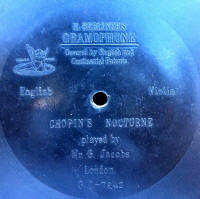
On this label may be seen the name "Rifanco Eagle". It is not known what Rifanco means or refers to, but the needles and gramophones available from Regent use the name too. Other label designs show the Rifanco Canary, Rifanco Marble and Rifanco Lion, as well as just Rifanco Brand.
The Besttone name was also used by the company as paste-over stickers on other record labels These were old stock sold by Regent; known examples are records previously sold by J. Blum & Co., such as Diploma & Pelican (see last two images here), following the liquidation of Blum & Co. in July 1915.
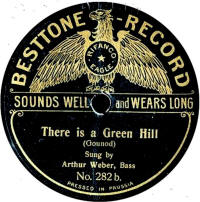
_small.jpg)
_small.jpg)
(sold in Australia)
Thanks to Derek Kell
and Rainer Lotz
for the label scans.
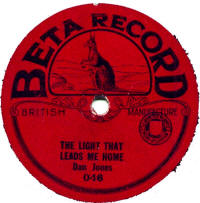
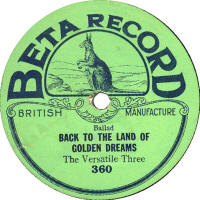
Any information, or images of examples of such records would be appreciated!
One example was the laughing robot for which this record was obviously a part, though I don't know what sort of product a laughing robot would be promoting! Is it a standard 10" sized record, but pressed in vinyl.
It is difficult to date this record from just an image, but this one has the date 14/2/1940 pencilled on it, so that gives a pretty good idea of the date!
Thanks to Adam Miller for the information and the label scan.
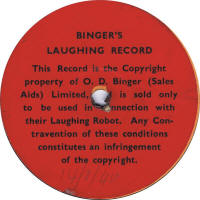
After leaving the Savoy Havana Band in 1926, he set up his own tuition school and in 1929, he recorded the first set of records to fit with the course.
These were called "Personal Demonstration Course In Modern Syncopation" and were recorded by Vocalion in December 1929. There were 4 records in the original course. Thanks to Brian Kilner for this information.
In 1931, he recorded another set, believed to be 6 records, called "Preliminary Course", again recorded by Vocalion.
Mayerl continued to run his Schools of Music until the late 1930s, when I believe he emigrated to Australia. On his return to Britain in 1949, he started the course up again, and had new sets of his original two courses re-recorded by the Gui de Buire recording company. The labels of these records still carry the original Vocalion matrix numbers, probably to aid matching up the records to the paper-based course, which was probably unchanged, but it is believed they are new recordings. Note the first course is now named "Modern Rhythmic Playing" rather than "Modern Syncopation".
The first image is an original Vocalion recording & pressing; the other examples shown here are post-WWII issues which state they are Gui de Buire recordings.
Thanks to Chris Macdonald for the first label image and to Bill Dean-Myatt for the others.
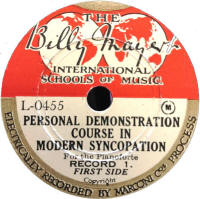
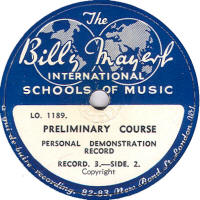
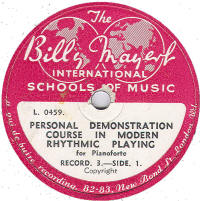
As far as I know, this is the only one seen, and it is catalogue number B1, so it may be the only issue!
Thanks to Bill Dean-Myatt for the label scan.
Thanks to Graham Farnell for the label scan.
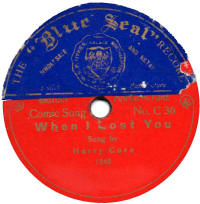
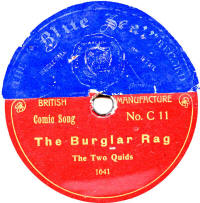
The records were manufactured in Germany by the Berolina Company, from masters they were also using on their Invicta Record which was produced for the London agent, John Abrahams. The catalogue numbers matched those on the Invicta issues, but that doesn't necessarily mean that all Invictas were also pressed up as Bob Records.
For now I am assuming they were imported into Britain, rather than manufactured here. It is possible the British-sold items may have copyright stamps, if anyone should even see any!
Thanks to Chris MacDonald for the image.
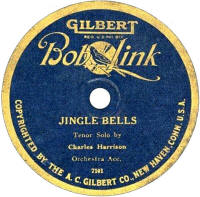
(sold in Australia)
Thanks to Mike Jones for the label image.
From 1937 until about 1967, B&H produced many records of 'music publisher' recordings in many different series.
The first image here is a pre-war example; the master numbers imply a Decca product from the late 1930s. Subsequently, the more familiar green label-style (also seen with a red backgroumd) were produced by Levy's and then finally EMI. The later records, still 10" 78rpm, where pressed in vinyl and the label design was simplified, being green with black printing (no white). These, still as 78rpm discs, were produced up until 1968.
The last example shown is of a private pressing.
Thanks to Bill Dean-Myatt for the label images.
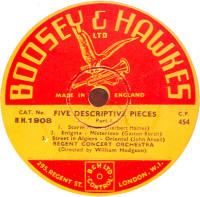

There were two catalogue series: one starting at B-1 and the other at B-1001. The B-1 series are 5½" records and the B-1000 series 6½".
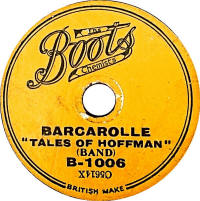
If you should know of any details of these early records, do email me.
The more familiar Bosworth records were introduced in early 1937. These were initially recorded and pressed by Decca, but subsequently by EMI. They contained music from scores owned by Bosworth, mainly what is now termed "Library music"; light music that could be used by radio, film and (later) TV producers as background music. I have a note that the records cost 5/9, but that sounds like a 1950s price. Louis Voss appears to be the main musical director for the orchestral recordings.
The catalogue starts at BC-1001 in 1937 and ran to BCV-1521 in 1968. The "V" in the prefix denotes records pressed in vinyl rather than shellac. It is not known exactly when the changover occurred, but I was told the BCV numbers started at 1240, though I have seen BC-1277 as a shellac issue, inplying if there was a considerable cross-over period where some were shellac and some vinyl.
The Decca recordings used CP- master numbers, formerly Crystalate's private series; the EMI recordings used their CTP-matrix series. It would appear Decca produced the early issues, but, again, there seems to be a cross-over period where both companies made Bosworths. For instance I have BC-1213 as my highest Decca issue, but BC-1154 is an EMI one. The vinyl examples I have here have BOS- series masters and no mention of EMI; I don't know who produced these. This prefix may imply Bosworth had their own studios, or it may be they were recorded by a company who used separate series for each client.
There were several other catalogue series in the late 30s & 40s:
BA- for South African items
BB- for Band music
BD-101 for dramatic productions
BE- for cinema or theatre organ music
BX- for mood music
Thanks to Bill Dean-Myatt for all the label images.

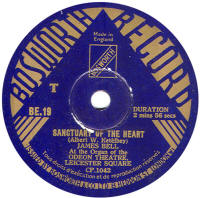
Association
My thanks to Bill Dean-Myatt for providing the label scan. I have had to adjust the brightness and I suspect the label colour would be the usual HMV plum.
My thanks to Charles Hippisley-Cox for providing the label image.
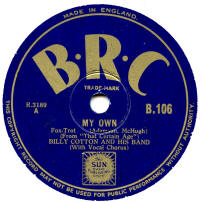
It has not yet been determined for whom the records were made, but it seems reasonable to assume there were quite a lot of them as the catalogue numbers on the currently known examples run from 357 to 461.
Even if they started at 300 (which would be odd - 100 is more likely) and run to 500, the fact that only three have appeared in recent years implies they were sold in very small numbers!
My thanks to Norman Field for providing the label scan.
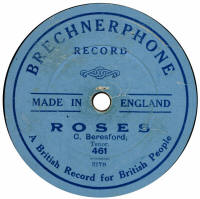
The records cost about 2/6 and were sold by the "tally man" system where the customer was contracted to buy so many discs over a year (about 50) for a fixed price, for which they received a new gramophone.

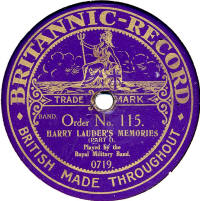
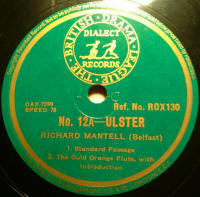
Thanks to Bill Dean-Myatt for the label image.
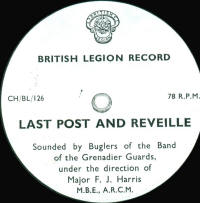
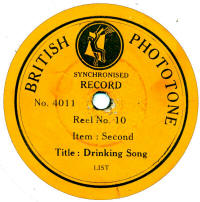
Information about any of these, or a decent scan would be appreciated.
This image seems to be of the only example ever found! Frank Andrews says the reverse side is by Alf Willis.
Thanks to Bill Dean-Myatt for the scan of the label

My thanks to Bill Dean-Myatt for providing the label image.
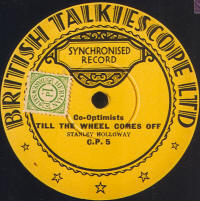
Thanks to Bill Dean-Myatt for the label image.
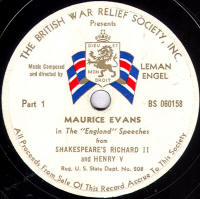
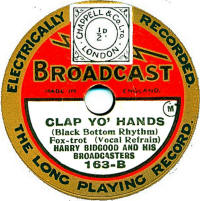
(all series)

Thanks to Bill Dean-Myatt for the scans of the labels
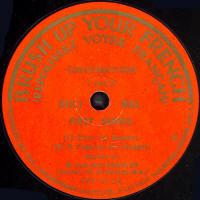
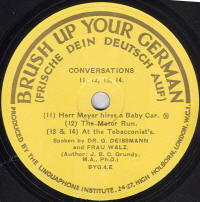
A very rare British label available from 1915 until 1920, and manufactured by Crystalate. The records cost 1/6 initially, but increased to 2/6 towards the end of WWI. there are several different label designs including the rather (by then) old-fashioned etched-and-filled labelling.
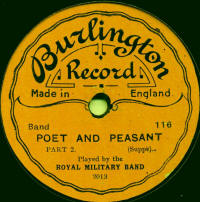
The first one was recorded & pressed by EMI.
Thanks to Bill Dean-Myatt for the scan of the labels
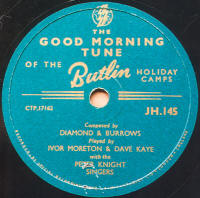
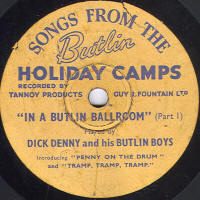
Thanks to Mike Jones for the label scan.
The other
version of Butterfly was a total or partial paste-over label used on old stocks
of "Popular", "Imperial" or "Mimosa" records, presumably as a way of disposing of them
cheaply (see second & third scans).

Thanks to Bill Dean-Myatt for the scan of the label
_small.jpg)